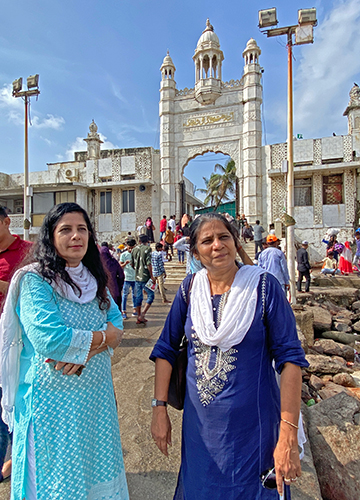Minakshi Sachdev first visited Mumbai’s Haji Ali Dargah as a college student. Now 50, she says trips there have become part of her routine. “Initially, it was just the scenic beauty around the dargah that pulled us in,” she says. “It was really beautiful to walk along that stretch and sit for hours on that marble floor, chit-chatting with friends with a cool breeze blowing on your face. It was as if we were in another world.”
Sachdev, who runs a general store in Dadar, says the urge to visit the dargah became more “pronounced, urgent and meaningful” over the years. She now goes there with her sister, Renuka Arora (56), or at times alone. “It did not matter that we were going to a dargah instead of a mandir,” says Arora, a regional sales manager at a leading Indian firm. “We frequent temples, too. This had nothing to do with religion. We just felt we were in harmony with God; with that divine power that had no shape or form.”
Over the years, the dargah, located on an islet off the coast of Worli in southern Mumbai, has turned into one of the city’s most iconic landmarks. It houses the tomb of Muslim merchant Pir Haji Ali Shah Bukhari, and draws in people not only with its spiritual calm, but also with its stunning white domes and minarets. The stretch leading to the dargah is packed with hawkers selling everything from shawls and models of the dargah to kebabs and biryani.
Charulata Khurana, 35, makes her weekly visit to the dargah in the quiet of dawn. “I am from a Brahmin family but not once did I have any doubts about visiting the dargah,” says the fashion designer from Thane. “My parents and grandparents never objected either. Whatever makes you feel at one with the divine is the right thing to do, they say. Here, I feel at peace. Early in the morning, when there are fewer people and I am away from the mainland, I feel detached and serene.”
Every time she visits the dargah, Khurana buys a shawl, some incense sticks, a holy thread and a garland before entering. Once inside, she offers the shawl and the garland to the “formless form of the saint” and ties the thread while making a wish. “I believe that my wishes are fulfilled here,” she says. “Who cares whether this divine power is Hindu or Muslim. As far as it can hear me, hear my prayers and grant me my wishes, I am at peace.”
Also read
- Harmony in diversity
- Inculcate mutual respect and reverence for all things divine: Sri Sri Ravi Shankar
- Why Lord Ganesh idols are installed in these dargahs
- Muslims donate land for temple in Madhya Pradesh
- How Ajmer Sharif Dargah empowers seekers of all hues
- On Ugadi, the first visitors to this temple in Kadapa are Muslims
Trishla Shah, a practising Jain and the mother of a three-year-old, started visiting the dargah with her husband, Ankit, after they got married 11 years back. Ankit visits the dargah every Thursday. “For us, it began more as a desperate call,” he says. “We had been trying to have a child for many years and it was only after visiting this and a few other dargahs, including the Ajmer Sharif, that our wish was granted. In fact, so strong is our faith in the dargah that we have taken our little one there as well; we believe that she will be infused with positivity and blessings of the divine.”


